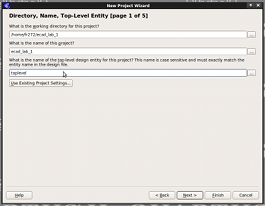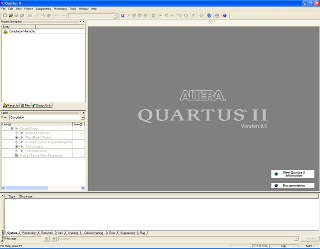ECAD and Architecture Practical Classes
Getting started - an introduction to Quartus
Starting Quartus and making a new project
First, create a new directory for this project in your filespace, perhaps called ecad_lab_1.
Important:Some tools in Quartus do not like paths with spaces in, so ensure all file and directory names you choose do not have spaces in them.
Into this folder, download the files:
tPad_pin_assignments.qsf
toplevel.sdc
toplevel.sv
The files are, respectively, the assignments file to tell Quartus what
pins on the FPGA to connect up to port names to be used in the Verilog code
(e.g. so the red LEDs can be named LEDR[17:0] in the interface of the top level
module); a design constraints file in Synopsys Design Constrain (SDC) format
which tells the tools about the input clocks; and the top level module for the
project, which connects all the other modules together.
You should now open the Quartus II 11.0 program from the Start menu. It is located under PWF Programs | Teaching Packages | Computer Laboratory | Altera 11.0 | Quartus II 11.0 | Quartus II 11.0 If you experience any licensing issues here, talk to a demonstrator for help. Once loaded, it should look like the screen on the left. At the bottom there is the status window, which produces compilation messages and warnings, which may be useful when trying to debug your project. On the left is the project outline window, this contains a list of all files that are part of your current project.
 Now, select File | New Project Wizard and click Next to take you
to the screen shown on the right. In the top box, type the directory where you
have just saved the 3 files above. In the second box, type the name of the
project, this can be whatever you like. In the lower box, type "toplevel" since
this is the name of the top-level SystemVerilog module for this project. Now
click Next.
Now, select File | New Project Wizard and click Next to take you
to the screen shown on the right. In the top box, type the directory where you
have just saved the 3 files above. In the second box, type the name of the
project, this can be whatever you like. In the lower box, type "toplevel" since
this is the name of the top-level SystemVerilog module for this project. Now
click Next.
On the next page, click Add All to add the files that were downloaded earlier into the project. If these files do not appear in the list, ensure you have saved them in the same directory that you specified as the working directory in the previous step. Alternatively, you can add them one at a time by giving the filename and click Add for each file. Now click Next.
This page lets you select the device you will be programming. In the drop down boxes at the top, select the family Cyclone IV E, the package type FBGA, the pin count 780 and the speed grade 7 and ensure that Specific device selected in 'Available devices' list is checked. Next, in the Available devices list at the bottom, select the chip with name EP4CE115F29C7. This is the type of FPGA that is on the DE2-115 board.
Now click Finish to create your project.
Finally, you need to import the pin assignments from the .qsf file you downloaded earlier. To do this, click Assignments | Import Assignments... click on the button labelled "..." and select the tPad_pin_assignments.qsf file. Click OK and then click OK again to import the assignments.
Important: Failure to assign pins will result in your design not being connected to the outside world and it will also be optimised to nothing since it doesn't have any used input and output signals, all of which is not very useful. You must import the assignments in every project you create.
Quartus uses Verilog 2001 as the default language but we'll be using SystemVerilog throughout. Change this default setting to SystemVerilog using Assignments | Settings... | Analysis & Synthesis Settings | Verilog HDL Input and then tick SystemVerilog-2005. Then hit Apply and OK.
Save these changes by clicking File | Save Project.

